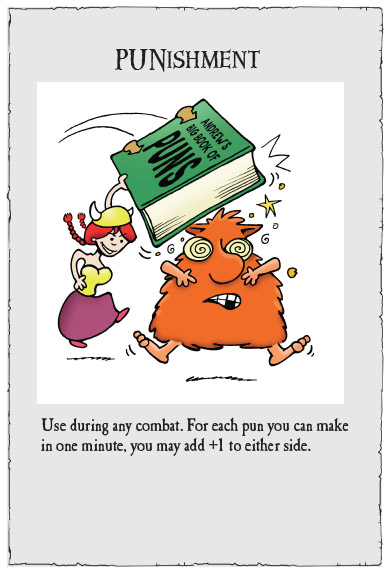TO BACKSTAB OR
NOT TO BACKSTAB
GAME THEORY AND THE
MUNCHKIN DILEMMA
Andrew Zimmerman Jones
We’ve all been there, standing next to our Warrior buddy (for lack of a better term) as he decides to kick down the door. There, on the other side, is an Unspeakably Awful Indescribable Horror.
The Warrior turns to us, asking for help. We have a moment – a heartbeat – to decide before the beast is upon us. In the words of the classic song, should we stay or should we go now? And, while running away, should we cast a spell to enlarge the Horror so it eats our friend?
This is the classic dilemma that faces players of Munchkin.
LOADED DIE: A WINNING STRATEGY
On one hand, my goal in the overall game is to beat my buddy, so I want to watch him get devoured by the Horror. As for the other hand . . . actually, this helps me out. I guess there is no other hand!
Well, that was easy. Maybe this isn’t a dilemma after all.
What’s that? He’s willing to bribe me? Treasure? I suppose I can reconsider the situation.
To figure out the best strategy, this shrieking geek looks to the mathematical field of game theory. The goal of game theory is to quantify the possible outcomes of a game, then determine which actions provide what payoff (either a gain or a loss). The game theorist is often able to develop an overall strategy that results in maximized rewards or minimized losses.
A game where the positive and negative payoffs, the gains and losses, exactly balance out is called a zero-sum game.
Assume that a Wizard and a Cleric are gambling at the tavern after their adventuring is done. They’ve been kicking in doors and looting all evening. So now they’re playing a simple game. Each places a flat bet of 1 gold piece, then they each flip over a card. The higher card takes the 2 gold pieces. There are three possible outcomes to this basic game:
| Wizard payoff | Cleric payoff | |
| Cleric card high | −1 gold | +1 gold |
| Wizard card high | +1 gold | −1 gold |
| Wizard & Cleric tie | 0 gold | 0 gold |

The amount of money one player wins is precisely balanced by the amount of money that the other player loses. Each combination of payoffs (each row in the table, in this case) adds up to zero, so this counts as a zero-sum game. It’s a fair game and there’s no strategy that might give either player an advantage over the other.
That’s not always the case.
At another table in the tavern, the Warrior and the Thief are playing a different game, one that the Thief has only recently taught to the Warrior. In this game, each player puts a two-sided coin down on the table, choosing whether to place it heads or tails. As the Thief carefully explains, the payoffs are as follows:
| Warrior heads | Warrior tails | |
| Thief heads | Warrior: −1 gold Thief: +1 gold | Warrior: 0 gold Thief: 0 gold |
| Thief tails | Warrior: +1 gold Thief: −1 gold | Warrior: −1 gold Thief: +1 gold |
This again is a zero-sum game, since the payoff combinations in each cell adds up to zero. But in this game there is a strategy that favors the Thief. If you add up the Thief’s payouts in a given row, you see that the sum when he plays heads is +1 gold and the sum when he plays tails is 0. If the Thief plays only heads, there is no chance that he will lose any gold pieces. He might very rarely switch over to tails just to throw the Warrior off the scam, but aside from this, his best strategy is to always go heads.

The Warrior’s situation is worse. Considering the sum of his payouts in the two columns, playing heads yields a sum of 0 gold while playing tails gives a sum of –1 gold. Playing tails is an overall losing strategy for the Warrior, so he will have to develop some sort of “mixed strategy” that involves playing heads some portion of the time and tails some portion of the time.
But because the Thief is playing a pure strategy of selecting only heads, the Warrior’s mixed strategy is never going to make up the difference, and he will lose money while never gaining any. Presumably, he will eventually figure out that the Thief is selecting nothing but heads, but not until he has lost at least a few gold pieces. The game is rigged so that the best the Warrior can hope for is to minimize his losses. The only winning strategy for the Warrior is to not agree to play the Thief’s game!
Just because something is zero sum doesn’t actually mean it is fair. That was, after all, why the Thief suggested this game in the first place. The Warrior would be better off clobbering the little sneak with an Eleven-Foot Pole and looting his body for the evening’s drink money.
HELP ME OUT HERE:
COOPERATION STRATEGIES
Cooperation took a while to show up in game theory, or in games for that matter. Many classic games don’t incorporate any element of cooperation at all. It is never a good strategic choice to cooperate with your opponent in checkers, chess, or backgammon, for example.
These games still count as zero-sum pursuits, though. If a move in checkers results in someone taking two pieces, then that player has gotten a +2 piece advantage while the other player has gotten a –2 piece disadvantage. This holds true even when you take into account the ability to gain the impressive-sounding title of king. Quantifying the value of the pieces is even trickier in chess, due to so many impressive-sounding titles, but it still counts as zero sum. There may be strategic reasons to take a momentary disadvantage to gain a greater long-term advantage for the win, but the benefits and losses of individual moves still result in these strictly competitive games also being considered zero sum.
It’s not a coincidence that one of the first competitive games where I ever encountered the idea of strategic cooperation was a non-zerosum design. It’s a little-known boardgame that involves the buying and selling of properties, the building of houses and hotels, and the raiding of municipal funds by greedy oligarchs. In this game, the strategy isn’t merely to crush one’s enemies, but to make deals with the other players. You have to give the other player something that he or she wants, but try to tailor the deal in such a way that you come out ahead.

Because players can gain money from the bank, it’s actually possible to gain payoffs that aren’t zero sum – most clearly evident when two players collude with each other to stomp a powerful third player. There’s a reason, after all, that this sort of behavior is (sometimes) illegal in real-world business practices: because the sum of two players working together is truly greater than any individual player could hope to be.
I haven’t played that game in quite some time, mostly because I’m still waiting for a Munchkin-based adaptation.
After the Thief awakens the next morning, head ringing from the beating he took, he limps back to his companions only to find them standing around a potion merchant’s wagon. The group is getting gear for their upcoming dungeon raid. The merchant sells mostly Electric Radioactive Acid Potions (complete with necessary hazmat gear), but he has one vial of the coveted Pollymorph Potion. The merchant announces that he will begin an auction for the Pollymorph Potion in a few minutes, but there’s a catch in this auction: everyone who bids has to pay their final bid, though the runners-up will get an Electric Radioactive Acid Potion for their trouble. A nearby paladin is on hand to make sure that no one agrees to the terms and then tries to weasel out of the deal.
The competitive strategy in this situation is obvious: everyone should go pawn off their useless junk so they can begin bidding on that Pollymorph Potion, doing whatever they can to gain it. It is, after all, the potion that they all really want.
But there’s an obvious problem here. If they all go for the Polly-morph Potion, they’ll be outbidding one another. And, given that they’re something of a spiteful bunch, they realistically know that things will get out of hand and they will all ultimately lose a lot of money, with only one of them potentially getting the Pollymorph Potion . . . assuming they aren’t all outbid by a smug, smartly dressed Bard who has just walked up to the wagon to join in the auction.
Instead of focusing exclusively on their individual goal – the desire to get the Pollymorph Potion – let’s say that the adventurers instead take a step back and consider the group’s overall goal. All four adventurers would like to buy a potion and have money left over for other gear. That will not happen if they all focus on the Pollymorph Potion.
There is another strategy available, though: if they all can agree to buy the Electric Radioactive Acid Potion, they won’t get into a futile bidding war, and they can go on about their day with a powerful new potion among their gear.
And it works fine, so long as no one breaks ranks and deviates from the plan.
KILL THE HIRELING:
DEFECTION AND BETRAYAL
Once the plan is set in motion, there’s always the possibility of someone deviating from it. This is called a defection from a cooperative strategy. While the other three adventurers are walking through the market looking for other gear, the Thief could decide to circle back and join in the auction for the Pollymorph Potion. But if any of the other adventurers notice that the Thief is breaking the agreement, they might decide to do so as well. Indeed, being petty and spiteful little munchkins, they will.
Game theorists have considered the consequences of this lack of cooperation in a classic game theory problem that’s become known as the Prisoner’s Dilemma. For our example, let’s say the night watch grabs a couple of adventurers, a female Warrior and a female Cleric, accused of having stolen a nobleman’s Staff of Napalm. (She’s a Cleric, not a priest.) Witnesses saw them breaking a window in the nobleman’s house, but there are no witnesses to the theft itself. Neither has the staff with her.

Without a confession, they’ll both spend a month in jail, at the very least, for having broken a window. Also, the nobleman wants one thing: the return of his Staff of Napalm. He’s offered a deal: if both confess and tell him the location of the staff, he’ll ask that they only be sentenced to three months apiece. If one confesses and the other does not, however, the night watch will have the evidence they need to send the one who doesn’t confess to jail for a year. The one who confesses will be set free as soon as the nobleman gets the staff back.
Oh, and the one who gets ratted out without confessing will get a finger chopped off.
It’s a harsh world out there.
Again, we can look at the possible payoffs in a table:
| Cleric keeps quiet (cooperates) | Cleric confesses (defects) | |
| Warrior keeps quiet (cooperates) | Cleric: 1 month in jail Warrior: 1 month in jail | Cleric: Goes free Warrior: 12 months in jail and loses a finger |
| Warrior confesses (defects) | Cleric: 12 months in jail and loses a finger Warrior: Goes free | Cleric: 3 months in jail Warrior: 3 months in jail |
The Warrior learned about life from her brother, a Warrior who once got fleeced gambling with a Thief in a tavern, so she thinks carefully about all of her options. She realizes that no matter what the Cleric does, it’s always in her own best interest to confess. If the Cleric keeps quiet, then confessing takes the Warrior from a one-month sentence to freedom. If both she and the Cleric confess, then the Warrior’s sentence will be reduced from a year to three months, plus she gets to keep all her fingers. She’s no idiot, so she decides to act in her best interest and confess.
The Cleric considers her options, as well. Her best strategy is to confess and hope that the Warrior keeps quiet, gaining her freedom at the expense of the Warrior. (She really is not a very good Cleric, but figures she can repent later.) If the Warrior does confess, then they both spend three months in jail, but at least everyone keeps all their fingers. Like the Warrior, she realizes that her best strategy is to confess.
Then the Cleric has an epiphany. Perhaps it comes in a vision from her deity. When they both confess, when they both act in a way that is clearly in their self-interest, the result is three months in jail apiece. But if they had both acted against their best interest, and held true to each other, their outcome would have been one month in jail apiece.
With this realization, the Cleric is renewed in her understanding of her mission in the service of her benevolent deity – to spread the good word of peace and cooperation throughout the land, so that people will live in accord with each other, attaining the best outcomes for society.
When the night watchmen return, the Cleric promptly confesses and tells them where the Staff of Napalm is. She may wish for a world where everyone can be trusted to act against her or his own best interest, for the good of the whole, but she’s not willing to bet her finger on it.
MUTILATE THE BODIES:
COOPERATION IN MUNCHKIN
The Prisoner’s Dilemma may seem like an abstract, highly contrived situation, but it has powerful implications in game theory, economics, and dungeon crawling.
Consider two companies competing against each other in the gaming industry. Zero-sum thinking says they must constantly work against each other, trying to gain an advantage.
For the non-zero-sum innovator, these competing gaming companies can benefit from mutual cooperation. They could create a hybrid product that uses the mechanics of a game system owned by one company, skinned with the intellectual property of another to create something new. Fans of both games will obviously love it, as will many fans of one game who had never played the other. Such cooperation benefits both parties, and also the gamers who love them, as shown by the existence of Munchkin Pathfinder Deluxe and Munchkin Panic.
After all of these side quests and adventures, consider again an adventurer (let’s go with a classless female Halfling) standing in the dungeon when her Warrior buddy kicks down a door, sees the Horror unspeakably before him, and looks over for help. He imploringly appeals to the Halfling’s friendship and sense of decency.
When that fails, he offers her a bribe.
This is a scenario that I have dubbed the Munchkin Dilemma. In one very important way, it’s significantly different from the Prisoner’s Dilemma: defection is not normally an option for the Warrior, only for the other players.
The Halfling can either cooperate or defect, and the defection can take several forms. She could simply refuse to help. Even more significantly, she (or any other player) could actively work against the Warrior in the fight, using Monster Enhancers to guarantee his defeat.
The Munchkin Dilemma is much more difficult to quantify than the cases we’ve looked at so far, because two types of payoffs are involved. For the Warrior, victory against the Unspeakably Awful Indescribable Horror means he gains a level and four treasure cards, less any cards offered in a bribe. If the Warrior doesn’t get help, he will lose. If he can’t run away, he’ll end up being killed and losing all his stuff. Everyone else in the party will loot the body.
The lack of defection by the Warrior makes the table a little different, but it’s still helpful in quantifying the various factors at play, depending on whether the Warrior can gain an ally or not in the fight.
| Payoffs | |
| Help the Warrior (cooperate) | Warrior: +1 level, some treasure cards Ally: Some treasure cards (+1 level if an Elf) Other Players: Tears and sorrow |
| Don’t help the Warrior (defect) | Warrior: No levels or treasure. Run away. Possible death. Other Players: Possible looting of the body, if Warrior dies |
The chance of any player cooperating in the fight comes down to negotiating what “some treasure cards” means. If the Warrior is offering to hand over his Tuba of Charm, the situation is very different than if he’s offering up his Staff of Napalm to a Wizard. Or the Warrior may offer the possible ally their choice of the treasure cards. If so, the person being asked to aid the Warrior is gambling on what cards will come up as treasure, determining how many of them he will get, and who gets to pick those cards.
The number of players is also a factor, because in a two-player game you are the Warrior’s only opportunity to avoid loss (and possible death). But if there are other people at the table and you insist on getting all four cards, the Warrior might be willing to turn you down, banking on the idea that someone else will help him for only two cards. Or, if everyone in the game drives too hard a bargain, he might just risk his chance to run away.
All the number crunching and odds figuring can be thrown out the window if the Warrior is willing to risk death just to spite other players.
REALLY IMPRESSIVE TITLE:
REPUTATION AND REPEATED PLAY
In the story of the staff-stealing Warrior and Cleric, the Cleric guaranteed that she would keep her finger by confessing – thus betraying her Warrior friend. She did so because she was fairly certain that the Warrior would also confess.
But the Cleric could have held to her convictions and said nothing, believing that it was nobler to remain true to her ally. (Assuming she has such convictions. Given that we are talking about an ally in stealing a Staff of Napalm, this particular Cleric continues to make some extremely skewed value judgments.) The Warrior had no similar convictions, so she confessed, betraying the Cleric.
A couple of years later, after the Cleric has gotten out of jail and regenerated her finger, she and the Warrior are again brought before the night watch for some crime. They are offered a similar deal.
This time, the Warrior has a piece of information that she didn’t have before: she believes that she can trust the Cleric to keep quiet, because she’s done it before. Everything she knows about the Cleric makes her absolutely certain that the Cleric will remain quiet this time, just as she did last time. It’s a bit of a leap of faith, but the Warrior figures that taking a leap of faith on a Cleric is a good bet.

Keep in mind that it’s still in the Warrior’s immediate best interest to betray the Cleric. With betrayal, the Warrior gets released that very night instead of serving a month of jail time. It would seem like the Warrior should betray the Cleric again.
Mathematicians have tried to figure out the best strategy for approaching the Prisoner’s Dilemma. In competitions, different strategies have been set against each other in rounds of competition. The “winning” strategy is the one that gets the least amount of jail time (or other penalty) throughout the course of the competition. Some strategies include always cooperating, always betraying, or randomly choosing betrayal or cooperation. These strategies are not particularly successful, though, as they have weaknesses that can be exploited by other strategies.
The strategy that proves the most successful is called Tit-For-Tat. When it encounters a new player, its first move is always to cooperate. Then, from that point on, if it encounters a player that it has played before, it copies the action that the other player made before. It doesn’t hold grudges for past slights (beyond the last one), it isn’t the first one to defect, but it also doesn’t ignore past betrayals entirely (as the Cleric seems willing to do). These three traits make it the most successful strategy in these repeated-play competitions.
Tit-For-Tat isn’t a perfect strategy. Other strategies can defeat it. In the most obvious example, if a Warrior using Tit-For-Tat were in a Prisoner’s Dilemma with a Thief who always betrays, the Warrior would begin by cooperating and be betrayed on the first round. On every other round, both the Warrior and Thief would betray each other, but the Warrior still lost on the first round, so the Tit-For-Tat strategy loses to the Always Betray strategy.
But the Always Betray strategy doesn’t do well in these competitions overall. Most strategies quickly figure out that the player is always betraying, and that reputation causes it to suffer over the course of repeated plays. Tit-For-Tat is flexible enough that it comes out ahead on average against more strategies.
The most important element of Tit-For-Tat is that reputation matters. Strategies that don’t take reputation into account always suffer for it. The Warrior’s decision needs to account for the fact that she will gain a reputation as someone who betrays her friends when it counts.
Reputation matters in the Munchkin Dilemma, as well. It’s likely that someone in that group is quickly going to prove to be far more mercenary than the other players, insisting on high payments for offering any help. Players who need help are likely to favor those who take a more, “Yeah, sure, I’ll help you out for just one treasure card” position.
Over repeated plays, being picked to help more often is likely to provide a greater advantage than rarely helping in exchange for massive bribes. A Halfling who is always willing to help for just a single treasure card can get several extra cards over the course of the game. The Elf, who gets a level bonus for assisting, will often help other players without taking any cards. Either of these players is more likely to be asked to help more often than the Warrior.
Part of the reason Munchkin is so much fun is that its play options and rewards are so diverse. They cannot be reduced to easily quantified payoffs and losses. Game theory helps us at least rule out the worst strategies. For those who haven’t learned this lesson any other way, it can teach that being a continual jerk is not a good strategy. It can teach us that ignoring, or even rewarding, bad behavior has negative consequences.
But it cannot offer guaranteed paths to success in every single situation. Even the best strategy, such as Tit-For-Tat, has its limitations. At times, reputation must be sacrificed for a truly great move.
Even those of us who enjoy a fairly light hearted, non-cutthroat version of Munchkin occasionally find ourselves in a position where we’ve agreed to help a level 7 Wizard fight a Bullrog in exchange for four treasure cards. Then, as we resolve the combat, we realize that we can use a Pollymorph Potion to get our treasure cards but prevent our buddy from getting two levels.
Sometimes, the circumstances just call for a good backstabbing. 
Andrew Zimmerman Jones was given a copy of Chez Geek as a housewarming present when he bought his home. Though he played Munchkin with friends, it took him an inexplicably long time to buy his own copy. While building up to the purchase, he was known to stand for hours in front of the Munchkin display at his local gaming store, contemplating which version was the perfect one. His wife eventually took pity on him and bought the core set. In between games, Andrew is a full-time freelance writer focusing on science, education, and popular culture. He is the Physics Expert at About.com and coauthor of String Theory for Dummies, as well as a contributing editor of Black Gate fantasy magazine. His work has appeared on a number of blogs and in popular-culture books, including Beyond the Wall and Inside Joss’ Dollhouse.
